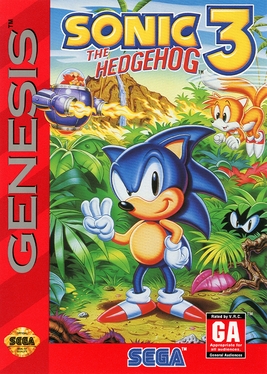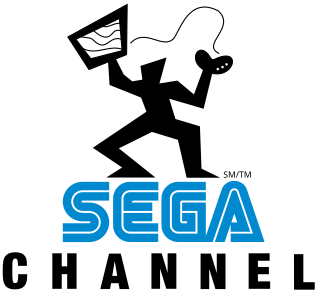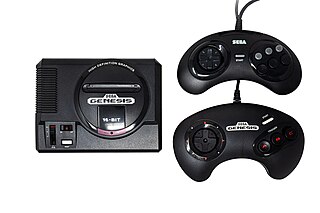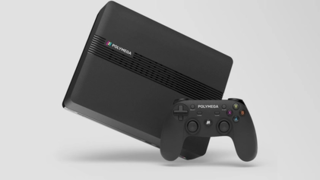
The 32X is an add-on for the Sega Genesis video game console. Codenamed "Project Mars", it was designed to expand the power of the Genesis and serve as a transitional console into the 32-bit era until the release of the Sega Saturn. The 32X uses its own ROM cartridges and has its own library of games. It was distributed under the name Super 32X in Japan and South Korea, Genesis 32X in North America, Mega 32X in Brazil, and Mega Drive 32X in all other regions.

Sonic the Hedgehog 3 is a 1994 platform game developed and published by Sega for the Genesis. Like previous Sonic games, players traverse side-scrolling levels while collecting rings and defeating enemies. They control Sonic and Tails, who attempt to retrieve the Chaos Emeralds to stop Doctor Robotnik from relaunching his space station, the Death Egg, after it crash-lands on a mysterious floating island. Sonic 3 introduces Knuckles the Echidna, the island guardian, who lays traps for Sonic and Tails.

The Master System is an 8-bit third-generation home video game console manufactured and developed by Sega. It was originally a remodeled export version of the Sega Mark III, the third iteration of the SG-1000 series of consoles, which was released in Japan in 1985 with graphical capabilities over its predecessors. The Master System launched in North America in 1986, followed by Europe in 1987, and then in Brazil and Korea in 1989. A Japanese version of the Master System was also launched in 1987, which features a few enhancements over the export models : a built-in FM audio chip, a rapid-fire switch, and a dedicated port for the 3D glasses. The Master System II, a cheaper model, was released in 1990 in North America, Australasia and Europe.
In the history of video games, the fourth generation of video game consoles, more commonly referred to as the 16-bit era, began on October 30, 1987, with the Japanese release of NEC Home Electronics' PC Engine. Though NEC released the first console of this era, sales were mostly dominated by the rivalry between Sega and Nintendo across most markets: the Sega Mega Drive and the Super Nintendo Entertainment System. Cartridge-based handheld consoles became prominent during this time, such as the Nintendo Game Boy (1989), Atari Lynx (1989), Sega Game Gear (1990) and TurboExpress (1990).

The Super FX is a coprocessor on the Graphics Support Unit (GSU) added to select Super Nintendo Entertainment System (SNES) video game cartridges, primarily to facilitate advanced 2D and 3D graphics. The Super FX chip was designed by Argonaut Games, who also co-developed the 3D space rail shooter video game Star Fox with Nintendo to demonstrate the additional polygon rendering capabilities that the chip had introduced to the SNES.

The Sega Channel is a discontinued online game service developed by Sega for the Sega Genesis video game console, serving as a content delivery system. Launched on December 14, 1994, the Sega Channel was provided to the public by TCI and Time Warner Cable through cable television services by way of coaxial cable. It was a pay to play service, through which customers could access Genesis games online, play game demos, and get cheat codes. Lasting until July 31, 1998, the Sega Channel operated three years after the release of Sega's next generation console, the Sega Saturn. Though criticized for its poorly timed launch and high subscription fee, the Sega Channel has been praised for its innovations in downloadable content and impact on online game services.

The Genesis, also known as the Mega Drive outside North America, is a 16-bit fourth generation home video game console developed and sold by Sega. It was Sega's third console and the successor to the Master System. Sega released it in 1988 in Japan as the Mega Drive, and in 1989 in North America as the Genesis. In 1990, it was distributed as the Mega Drive by Virgin Mastertronic in Europe, Ozisoft in Australasia, and Tectoy in Brazil. In South Korea, it was distributed by Samsung Electronics as the Super Gam*Boy and later the Super Aladdin Boy.

Mega Man: The Wily Wars is a 1994 video game compilation developed by Minakuchi Engineering and published by Capcom for the Sega Genesis; the compilation features remakes of the first three Mega Man games, alongside a new game called Wily Tower, only unlockable with a completed save file.
The Sega Card, known in Japan as Sega My Card, is a memory card format used as game storage for the SG-1000/SC-3000 and the Mark III / Master System. Produced from 1985 to 1987 by Mitsubishi Plastics, the cards are plugged into onboard cardslots or into compatible adapters. Several versions of the format were created, including a rewritable one that allows new titles to be downloaded to a card. While substantially cheaper to produce than cartridges, the storage limitations of the format resulted in Sega exclusively distributing games on cartridges. Despite the failure of the Sega Card, NEC found more success with its own memory card format, the HuCard, which was the primary storage medium for its PC Engine game console.
RetroN is a series of video game consoles created and developed by Hyperkin which allows users to play video games from consoles such as the Nintendo Entertainment System and the Super NES. Since the release of the RetroN 5, they have been connected via HDMI. The latest in the series, RetroN Sq, was released in 2021.
Analogue, Inc. is an American company that designs, develops, and sells video game hardware. Its hardware products include the Analogue Pocket, Analogue Mega Sg, Analogue Super Nt, Analogue Nt Mini, and Analogue Nt.
The Analogue Nt Mini is a video game console designed and manufactured by Analogue It was designed to play games for the Nintendo Entertainment System and the Famicom, like the original Analogue Nt. Unlike the former, the Nt Mini uses an FPGA for processing.

The Analogue Super Nt is an FPGA-based home video game console designed and manufactured by Analogue It is designed to be compatible with games for the Super Nintendo Entertainment System.
Ultracore is a run and gun video game developed by DICE. Originally due to be released for Amiga, Genesis, and Sega CD platforms, the game was canceled by its publisher, Psygnosis, in 1994 after it had been almost finished. The game was salvaged by publisher Strictly Limited Games and released together with the Mega Sg aftermarket console in March 2019. Ports for Nintendo Switch, PlayStation 4, and PlayStation Vita released in 2020. A version compatible with original Sega Genesis systems was released in Japan in October 2019. Ports for Xbox One and Xbox Series X/S released in December 2023.

The Sega Genesis Mini, known as the Mega Drive Mini in regions outside of North America, is a dedicated console modeled on the Sega Genesis. The Mini emulates the original console's 16-bit hardware, and includes 42 games made available through emulation software by M2. It was released in North America and Japan in September 2019 and in Europe and the Middle East in October 2019. A follow-up, Sega Genesis Mini 2, was released in October 2022 and includes 60 games from the Genesis and Sega CD.

Paprium is a side-scrolling beat 'em up video game for the Mega Drive developed by studio WaterMelon and released in 2020. It was announced as part of a crowd-funding pitch in 2012. Development took eight years, with little to no communication with game's backers or the press, and was widely considered to be vaporware.

Polymega is a home video game console developed by American company Playmaji, Inc. It is a retro gaming console offering backwards compatibility with several CD-based platforms: PlayStation, TurboGrafx-CD, Neo Geo CD, Sega CD, and Sega Saturn. It also supports cartridge-based platforms, including Nintendo Entertainment System (NES), Sega Genesis, Sega 32X, Super Nintendo Entertainment System (SNES), and Nintendo 64. It includes a built-in CD drive, while separate add-ons known as Element Modules provide support for cartridge-based games. It was announced as the RetroBlox in 2017, and faced numerous delays before being released in September 2021.












